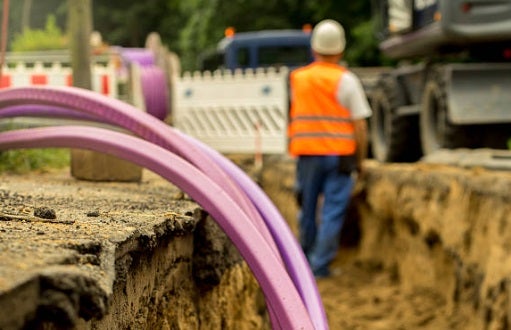A Status Update: Kinex says regional broadband project on track
Published 8:53 pm Wednesday, January 3, 2024
|
Getting your Trinity Audio player ready...
|
Despite the occasional hiccup, the massive $25 million effort by Kinex to lay nearly 1,200 miles of fiber optic cable in Prince Edward County and across the region remains on-track. And when it’s done, the access to high-speed internet in many neighborhoods across Cumberland, Prince Edward and Lunenburg counties could make working from home not just a remnant of the coronavirus pandemic, but the norm.
At least that’s what Jim Garrett, founder and president of the company behind the project — Kinex Telecom — believes.
“I personally think lawmakers need to get creative and change the way we tax,” Garrett said in an email interview. “With the new broadband, we will have the opportunity to work from home while we take care of elderly parents or challenged children. And we will drive less.”
Garrett participated in a regional economic survey soliciting ideas on how to grow the tax base here through a number of approaches, including clearing the way to construct more buildings. But funding schools and public safety shouldn’t be dependent on how much a community can build.
“We need to change tax laws so we do not look for ways to create buildings to generate revenue,” Garrett said. “To me, that process is using antiquated thought and is truly going backwards. Big cities have empty buildings because people are working remotely. Buildings are foreclosed on. They depreciate. And tax revenue is lost.
“Why would we follow that model now that we will have great broadband?”
Kinex officials look ahead
Kinex finalized a contract with the Rural Digital Opportunity Fund in early 2022 before burying 45 miles of fiber in Lunenburg between Kenbridge and Victoria. Kinex then secured a $15 million grant from the Virginia Telecommunications Initiative.
From there, Kinex took on the western side of Prince Edward, Garrett said, and headed south through Lunenburg, before turning east, and working cable back up into Prince Edward through Cumberland to “connect the loop.”
“The design is one big ring for redundancy, so a cut on that backbone will allow the network to self-heal from the opposite direction,” Garrett said. “We then go back and extend all laterals off of our ring and install clients.”
Kinex is working on two different timelines on the project, given until 2025 for the state project, and 2029 for areas targeted by the feds through the opportunity fund. Garrett says he expects to stay on schedule for both, but there are some factors that are getting in the way.
One setback came earlier this year when a company tasked with marking other underground cables so they wouldn’t be damaged in the fiber installation project simply wasn’t keeping up with the schedule.
“We had to release two crews rather than have them sit in their hotel rooms waiting for markings,” Garrett said. “That caused us some delays.”
The marking company, however, expanded its workforce, but still couldn’t keep up, Garrett said, so a new company has since stepped in.
Back on schedule
“Right now, we are pretty much caught back up to our planned schedule.” Garrett said.
Yet, that could change again — not because of a personnel shortage, but instead from issues with the supply chain. The Broadband, Equity, Access and Deployment Program — more commonly known as BEAD — is spending more than $42 billion to expand high-speed internet access across the country.
Signed into law by President Joe Biden in 2021, the Infrastructure Investment and Jobs Act has dedicated more than $1 trillion toward transportation and infrastructure development, funding programs like BEAD.
Virginia projects could be awarded as early as this coming April. And when that happens, it could complicate projects like the one led by Kinex because labor and material already are in short supply, and BEAD could make it worse.
But BEAD is no surprise, and Garrett says Kinex has been preparing.
“We ordered materials way in advance, and have the next year’s fiber on-hand,” he said. “We have recurring loads of innerduct (the tubes that would house the cable underground) and vaults scheduled. But with BEAD coming, that could get complicated.”
But when it’s all done, Garrett believes this fiber will be the kind of game-changer the region hasn’t seen since telephone and electrical lines were first strung up more than a century ago.
Working from home
In the wake of the coronavirus pandemic, nearly 13% of full-time employees still work from home, according to a report earlier this year from Forbes magazine. More than 28 percent work a hybrid model, where they mix at-home and in-office time.
Yet, that could change in the coming year when nine out of 10 companies surveyed say they intend to bring all employees back to the workplace full-time by the end of 2024, according to a CNBC report. For those businesses, establishing and maintaining corporate culture is key to keeping employees engaged, and to help stop them from leaving to go somewhere else. However, that culture can’t be cultivated if employees aren’t spending at least some of their time all in the same place.
Garrett finds that approach short-sighted, and maybe even ignorant of what technology now offers. And he hopes the continued expansion of high-speed internet access in areas that never had it before will continue to fuel what he sees as a cultural evolution, accelerated by the troubled times of the pandemic years.
“Society is changing because of a world connected by broadband,” he said. “We need to figure out how to be the leaders, and not the followers.”






